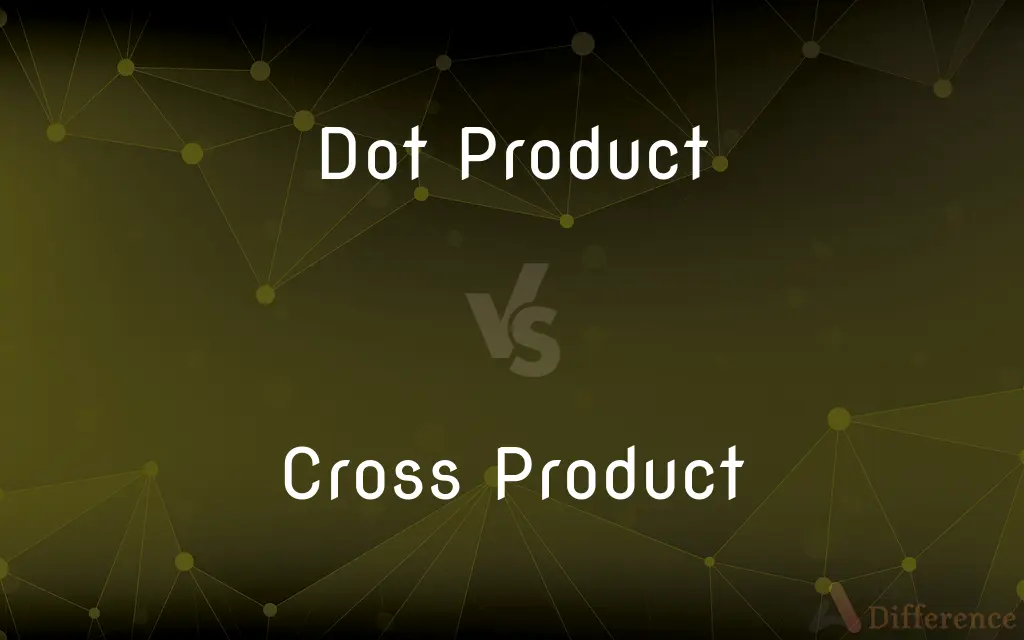Dot Product vs. Cross Product — What's the Difference?
By Tayyaba Rehman — Published on October 29, 2023
Dot Product is scalar obtained by multiplying vector magnitudes and cosine of their angle. Cross Product is vector orthogonal to two multiplied vectors, magnitude equal to their product and sine of their angle.

Difference Between Dot Product and Cross Product
Table of Contents
ADVERTISEMENT
Key Differences
In mathematics, particularly vector algebra, the Dot Product (also known as scalar product or dot product) provides a means of multiplying two vectors to yield a scalar. Fundamentally, it combines two vectors, taking the product of their magnitudes and the cosine of the angle between them.
Contrastingly, the Cross Product (vector product) multiplications of two vectors yield a vector as the result. When two vectors are multiplied using the cross product, the resultant vector is orthogonal to the plane formed by the original vectors. Furthermore, the magnitude of the resultant vector from a cross product is equal to the product of the magnitudes of the two vectors and the sine of the angle between them.
The dot product can express the geometric relationship between two vectors, providing the projection of one onto the other, thus indicating the extent to which one vector extends in the direction of another. This method is pivotal in generating a vector that is perpendicular to a defined plane.
Comparison Chart
Result Type
Scalar
Vector
Operational Formula
A·B = |A| |B| cos(θ)
A×B = |A| |B| sin(θ) n
ADVERTISEMENT
Dimension Application
Applicable in any dimension.
Generally applied in three dimensions.
Geometric Interpretation
Amount one vector projects in the direction of another
Vector orthogonal to the plane of the two input vectors
Usage
Work calculations, angle between vectors
Torque, area of a parallelogram, direction perpendicular
Compare with Definitions
Dot Product
Product of magnitudes and cosine of the angle between.
The dot product is positive if two vectors point in a similar direction.
Cross Product
Produces a vector perpendicular to two multiplied vectors.
The cross product of i and j is k.
Dot Product
Indicator of projection length of one vector onto another.
Dot product provides insight into how much one vector projects onto another.
Cross Product
Utilizes the right-hand rule for directionality.
Using the cross product, determine vector direction with the right-hand rule.
Dot Product
Scalar result of two vector multiplication.
The dot product of two perpendicular vectors is zero.
Cross Product
Finds a vector orthogonal to a defined plane.
The cross product can specify normal vectors in 3D space.
Dot Product
Tool for calculating work done by a force.
The work done is obtained by taking the dot product of force and displacement vectors.
Cross Product
Calculates a vector with magnitude equal to the product of two vector magnitudes and sine of their included angle.
The magnitude of the cross product also represents the area of the parallelogram formed by two vectors.
Dot Product
A method to find the angle between two vectors.
Using the dot product, the cosine of the angle between vectors can be found.
Cross Product
A vector operation restricted usually to three dimensions.
In physics, the cross product helps determine the direction of resultant vectors in three-dimensional space.
Common Curiosities
Is the Dot Product commutative?
Yes, A·B equals B·A.
Is the Cross Product applicable in 2D spaces?
Typically not, it's mostly utilized in 3D.
What type of result does the Cross Product yield?
A vector.
Does the Dot Product indicate vector directionality?
No, it yields a scalar, not directional information.
Can the Dot Product be used to find angles between vectors?
Yes, using arccos(A·B / (|A||B|)).
What is the relationship between the magnitudes in the Dot Product formula?
Multiplicative and involving the cosine of the angle between.
Does the order of multiplication matter in Cross Product?
Yes, A×B is not equal to B×A.
Does the Dot Product apply to non-Euclidean spaces?
It can, with adaptations for non-orthogonal bases.
Can Dot Product be applied in 3D vector spaces?
Yes, it is applicable in any dimensional space.
In what applications is the Cross Product often found?
In physics, like calculating torque.
What determines the direction of the Cross Product vector?
The right-hand rule.
What does a Dot Product of zero imply about two vectors?
They are perpendicular.
How is Dot Product represented symbolically?
Often as "A·B" or "(A, B)".
Can the Cross Product be used for non-geometric applications?
Yes, in various vector analyses in physics and engineering.
Is the Cross Product defined in four-dimensional space?
Not commonly, it's typically applied in 3D.
Share Your Discovery

Previous Comparison
Competitive Advantage vs. Core Competence
Next Comparison
Poultry vs. MeatAuthor Spotlight
Written by
Tayyaba RehmanTayyaba Rehman is a distinguished writer, currently serving as a primary contributor to askdifference.com. As a researcher in semantics and etymology, Tayyaba's passion for the complexity of languages and their distinctions has found a perfect home on the platform. Tayyaba delves into the intricacies of language, distinguishing between commonly confused words and phrases, thereby providing clarity for readers worldwide.
















































